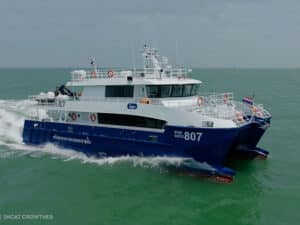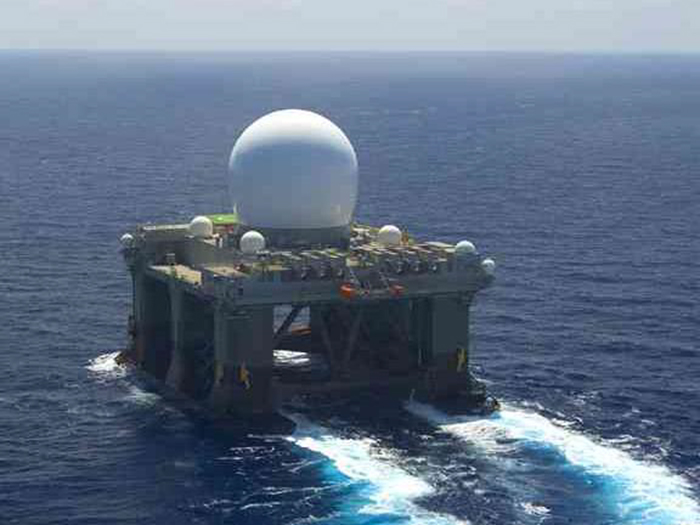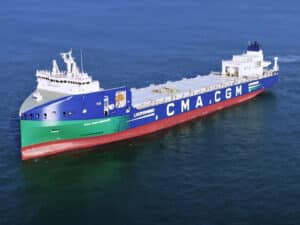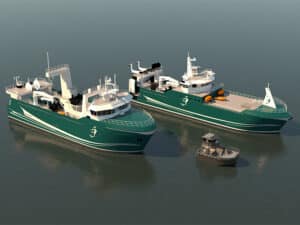
EBDG weld procedure reduces downtime for critical defense asset
Written by Marine Log Staff
SBX-1 is based on a semi-submersible hull [Image: USN/TOTE Services]
Naval architecture and marine engineering firm Elliott Bay Design Group (EBDG) reports that it led a complex weld engineering and inspection project for the USNS SBX-1 that included developing an optimized weld procedure for an uncommon grade of steel for TOTE Services, LLC, in support of work on the vessel.
The regulatory agencies in control of the approval and oversight of the procedure included the American Bureau of Shipping (ABS) and United States Coast Guard (USCG), in support of the ultimate owner, the Department of Defense (DoD) Military Sealift Command (MSC).
The Sea Based X-Band Radar dates back to 2003, when the U.S. government purchased a 50,000-ton semi-submersible platform from Norway’s Moss Maritime. The platform vessel received modifications at the Keppel AMFELS shipyard in Brownsville, Trxas, Kiewit Offshore Services in Ingleside, Texas, and Pearl Harbor Naval Shipyard in Honolulu, before entering service in 2006.
The vessel is part of the United States Department of Defense Missile Defense Agency and provides key tracking and identification of potential ballistic missile threats. .
The challenge for EBDG’d effort was to develop a regulatory-approved weld procedure appropriate to the exotic grade of steel used for the hull of the SBX-1. The steel is an ABS) grade FH-36 low temperature steel. It is suitable for service in arctic conditions as it retains higher impact toughness in very cold ambient temperatures when compared to more common ABS grade A steel.
THE CHALLENGE
As the SBX-1 is a semi-submersible platform vessel, it was necessary to cut large access hatches in the hull columns to extract equipment being refurbished and replaced. The work required replacement and re-welding of the access cutouts in steel plating up to 40 mm (over 1.5 inches) thick.
The weld procedure used previously on the vessel for a similar project required extensive post weld heat treatment (PWHT). The heat treatment was necessary to ensure the completed weldment had satisfactory low temperature impact strength. Using the standard approach with PWHT required that the steel be brought to and held at 1,100 degrees F, and back to ambient in a controlled manner over many hours. Further complicating the process, the required heat-controlled area extended over a large exterior area of the vessel thus requiring customized high temperature heat blankets and a specialized subcontractor to execute the work. This resulted in significant cost and schedule impact occurring at the very end of the shipyard period.
The objective was to develop a new weld procedure which did not require this extensive PWHT effort.
THE SOLUTION
EBDG reports that it developed a new weld procedure specification (WPS) that is practical to implement in the field and provided the required cold temperature toughness, without expensive and time intensive post weld heat treatment.
The comprehensive approach included both development and testing of the new weld procedure. In addition to developing the procedure itself, EBDG procured the test material plates, arranged the plate preparation with a local steel vendor, worked with a fabrication shop to create the test assembly weldments, subcontracted the nondestructive and destructive testing, and coordinated regulatory review and approval.
BACKGROUND
For the ABS steel on this project, the critical material property to manage was toughness, which is a measure of the ductility of the steel at the lower required temperatures. When steel is welded, it changes from solid to liquid and back again. The rate at which the steel transitions between phases impacts the resulting microstructure of the steel. For this case, excessively rapid cooling of the weld puddle results in brittle microstructures unsuitable at low temperatures. The cooling process is also influenced by the thickness of the material being welded. Thick plates such as those on SBX-1 act as a heat sink, drawing heat rapidly away from the joint. EBDG determined an appropriate size for the test assemblies that would approximate the cooling rates for the actual vessel joints. The size of the test assemblies used was significantly larger than the minimum size required by ABS for approval of the weld itself. This extra effort gave us greater confidence our test results would effectively represent the actual installation.
There are two general approaches to control the initial rate of cooling of a weldment: preheating the joint, and heat input during the welding process. Preheat is a process of raising the temperature of the base metal above ambient prior to welding by using a torch or other heat source. Heat input during welding is governed by the arc energy (volts and amps) and the travel speed of the welder. EBDG calculated the maximum allowable initial cooling rate and identified the ranges of acceptable welding parameters. The firm also established a range of preheat for our test assemblies.




